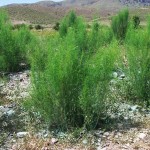Burrobrush, Singlewhorl Burrobrush, Cheeseweed
Hymenoclea monogyra Torr. & A. Gray
Asteraceae (Sunflower Family)
Description
Burrobrush is a native perennial that is also called Cheeseweed or Cheesebrush because when crushed, the leaves give off an obvious cheese-like odor. This upright shrub usually grows between 2 to 8 feet or 0.6 to 2.4 m tall. The thin stems and branches arise from a single base and often arch out and bend toward the ground. Burrobrush leaves are located alternately along the stem, are generally threadlike, dark green, sessile, and about 1 to 3 inches long. The leaf’s lower surface is smooth or glabrous, and the upper surface is grooved with minute white hairs. The plant produces clusters of yellow to green or white flowers that can bloom from March to October but bloom profusely in the fall. Female and male flowers may occur in the same cluster or separate heads. The male flowers have translucent, white corollas that are clustered in the leaf axils. The female flowers are also in the leaf axils and have rounded, fruit-bearing structures. The seeds are formed within a winged bur. The fruit, or bur, has a distinct whorl of papery bract wings around the middle. Livestock typically avoid Burrobrush. Small mammals and birds may consume seeds.Habitat
Burrobrush is found on dry and well-drained sites with alluvial soils in the Trans-Pecos and Edwards Plateau areas. Its distribution includes Arizona, California, Nevada, New Mexico, and Texas. Elevation ranges from 1,000 to 4,000 ft or 305 to 1,200 m. Habitats include sandy washes and streams, floodplains, and arroyos. It is drought tolerant.Images
Plant Characteristics
Flower Color: Green, White, Yellow
Seed Type: Fruit/Berry
Duration: Perennial
Stem Texture: Hairless/Smooth
Growth Habit: Shrub (Woody)
Leaf Shape
 : Simple with Pinnate or Parallel Venation
: Simple with Pinnate or Parallel Venation
Season: Semi-Evergreen, Warm
Distribution
 : 06 - South Texas Plains, 07 - Edwards Plateau, 10 - Trans-Pecos
: 06 - South Texas Plains, 07 - Edwards Plateau, 10 - Trans-Pecos
Distributions
Distribution refers to the ecological region in Texas that a plant has been found. You can also view a clickable map.
Book: Brush and Weeds of Texas Rangelands (B-6208)
Collection: Brush and Weeds





